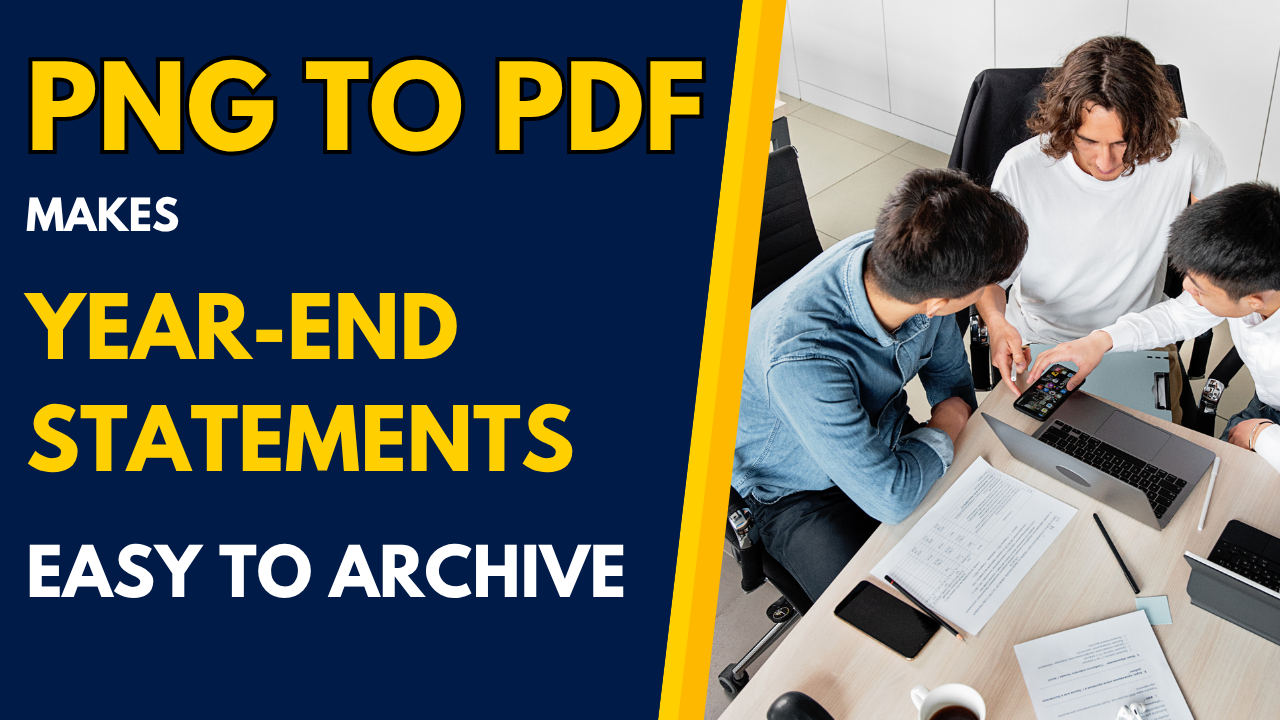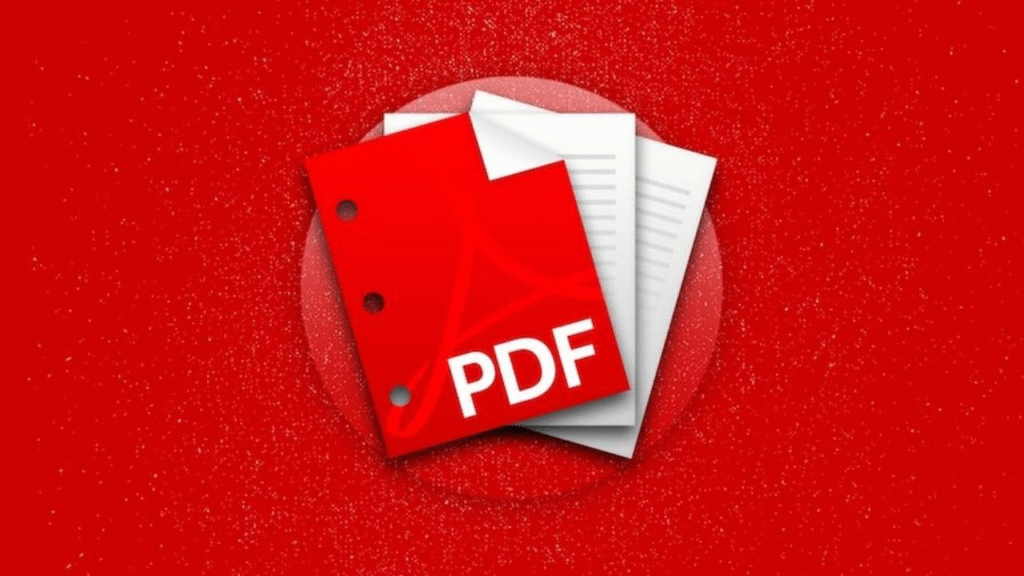PNG to PDF Makes Year-End Statements Easy to Archive

Main Points
- PNGs are clear but hard to manage.
- They lack search and structure.
- Year-end sorting becomes chaotic.
- PDFs support searchable content.
- PDF conversion improves usability.
- PDFs align with financial tools.
- Monthly conversion saves time.
As the year comes to an end, most people and professionals are saddled with the same old anxiety: putting together disparate financial reports. Bills and bank statements, receipts and invoices, these documents accumulate in a disarray of file types, particularly PNG images snapped from cellphones or received via portals.
While PNG images provide visual clarity, they are not intended for long-term record-keeping. They are difficult to search, challenging to organize, and consume unnecessary space. Having dozens of image files can easily become complicated when gearing up for audits, tax return preparations, or merely storing personal documents.
This article describes the essential issues individuals encounter when working with unstructured year-end statements. It also tells a true story about how it is possible to reorganize image files with a simple utility such as an online PNG to PDF converter and turn a disorganized set into a tidy, usable archive.
Struggling to Organize Year‑End Financial Statements

Organizing a year’s worth of receipts, bills, bank statements, and salary slips tends to result in a confusing medley of file types, particularly PNG images from screenshots, scans, or downloads. This combination creates several stress points:
Why PNGs Make Chaos Worse
PNGs are picture-perfect but are not searchable or embedded with metadata.
They become clumsy when handling dozens of files, particularly during audits or tax preparation, when speed and precision are important.
Without conversion, chronology is lost. Even proper naming (e.g., “2024‑Nov_InternetBill.png”) only goes so far.
The Hidden Cost of Disorganized Files
Disorganization isn’t just inconvenient it comes at a cost. According to a report by Foxit, 83% of employees have had to recreate documents they couldn’t locate, and poor file management practices can result in an average 21.3% productivity loss in document-centric environments.
While the figure quotes office efficiency, the principle is the same for people. Time lost searching for misplaced PNGs or attempting to recreate lost records causes tension and delays in personal work such as filing returns, applying for a loan, or working on home budgets.
Why PNG Files Complicate Year-End Archiving
End-of-year documentation usually includes collating an assortment of financial evidence—rent slips, utility bills, screenshots of payments, salary reports, and expense claims. Several of these are stored as PNG files because they have good visual quality and are quick to capture. Yet when it is a question of assembling and storing records for the long term, PNGs may create more issues than they solve.
No Native Indexing or Grouping Without Human Intervention
Unless you rename all the files yourself with a standard naming convention (say, “2024_March_ElectricityBill.png”), PNGs can get in the wrong order and be labeled incorrectly. This makes it hard to compare months or chronologically track them. There is also no native means of tagging or grouping images, so folders fill up with clutter and become hard to sort through as files accumulate.
Minimal Integration with Accounting and Archiving Solutions
A majority of accounting software, bookkeeping tools, or electronic archiving systems expect PDF or spreadsheet input. PNG files are usually an additional step to convert, or are simply not supported. This creates friction in processes, whether you’re adding proofs for expense reports or submitting supporting documents for tax filings.
Hard to Manage in Bulk
PNG files are easy to handle in low volumes, but become cumbersome to manage when processing frequent transactions. Freelancers, entrepreneurs, or anyone who handles both personal and business finances commonly end up with dozens or hundreds of image files at the end of the year. It takes time and is prone to errors to store, tag, and refer to each one separately.
Chronological Confusion and File Order Issues
Even if files are dated when they are saved with date-stamped file names, the folder’s default sorting order can get them out of sync, particularly if file names are not consistent. A file saved as “March_Bill.png” can end up above “February_Statement.png” alphabetically. It is more difficult to follow timelines, confirm sequences, or produce monthly summaries.
Case Study – “I Couldn’t Keep My Financial Records Straight”
Being a freelancer with several clients and personal bills, I developed the practice of saving receipts and confirmations throughout the year. Most of these were taken as screenshots or scans in PNG format fast, easy, and legible.
But I didn’t know how unorganized things were until December. My phone gallery, cloud storage, and downloads folder were full of files such as “screenshot_2024-05-08.png” or “scan0003.png.” There was no date-based organization, no naming pattern just a visual clutter.
Wasting Time During the Crunch Period
When taxes came around and it was time to report, I figured that I could simply gather the files together within a couple of days. What happened was hours of opening image after image, renaming manually file after file, and ensuring multiple times if I’d already saved particular documents.
A Simple Fix That Worked
I sorted my PNG files by month and batch converted each group into a PDF with an online PNG to PDF converter. This enabled me to combine similar files, name them in a straightforward manner (e.g., 2024_Q2_Receipts.pdf), and put them into one central folder.
The outcomes were instant:
I was able to find a month’s worth of records in seconds
Sharing or attaching files for tax filing was a breeze
My file repository was neater, less bloated, and more convenient to back up
What I Learned
I discovered that it isn’t just enough to save documents—organization and storing them is what counts. Saving my PNGs as organized PDFs not only streamlined year-end filing but also provided me with a system I could utilize during the year.
Now, rather than experiencing last-minute panic every December, I take a few minutes a month to get organized and archive my records. It’s a habit I wish I’d adopted earlier.
Benefits of Archiving in PDF Format

PDF archiving year-end fiscal records is more than convenient it establishes a sound, structured method of storing invaluable information. Though PNG files are popularly employed to snap receipts, bills, and confirmations, they do not include the functionality necessary for productive long-term documentation.
Maintains Visual Acuity with Enhanced Functionality
PDFs preserve the clarity and resolution of PNG images, be it a scanned electricity bill or a digitally signed salary slip. While PNGs do not support selectable text, clickable links, or embedded bookmarks without sacrificing the visual fidelity of the original file, PDFs make all these possible.
Supports Searchable Text and Storage of Metadata
A main drawback of PNG files is that they’re image-oriented and non-searchable. PDFs, however, can have layers of text and metadata such as dates, titles, and document properties. This allows for effortless searching of a file by keyword, which is particularly useful when handling dozens of statements simultaneously.
Optimizes Storage Through Compression
Whereas PNGs provide high resolution, they usually come at the expense of file size. One month’s worth of PNG bills could take up unused storage space. PDFs provide compression without losing quality, which makes them useful for cloud storage, email attachments, and backup systems.
Bottom Line
Financial record archiving isn’t simply a matter of storing documents it’s making those documents easy to read, understand, and apply when required. PNG files, although visually convenient for taking snapshots of stand-alone documents, are soon impossible to handle as volumes increase. Converting them to PDFs at year-end adds order and avoids the risk of clutter.
Creating the required monthly routine of gathering files into searchable, compressed PDFs allows individuals to steer clear of the eleventh-hour process and enhance the precision and dependability of their financial records, year in and year out.


